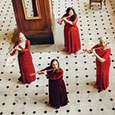Jennifer Amox teaches flute at Henderson State University in Arkansas where she prepares students for careers in music education and develops innovative programs with her flute choir including a popular collaboration with the university’s physics students.
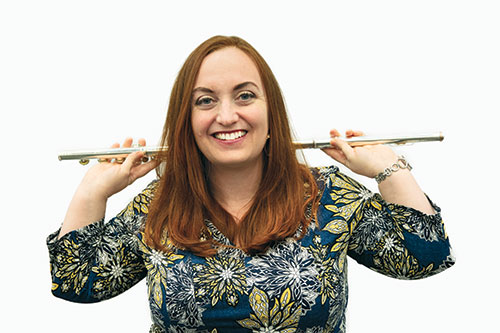
During my third year at HSU, my friend and colleague, Shannon Clardy, approached me about presenting a flute choir concert in the university’s planetarium as a fundraiser with the Society of Physics Students. Shannon teaches adjunct oboe in the music department and is also a tenured professor in astrophysics. She imagined a concert that would accompany and enhance a pre-existing planetarium show, and the Celestial Harmony concert series was born.
My flute choir was young; it had only recently grown to six members, and most of them were inexperienced freshmen. I immediately looked for music with space and flight-related keywords and found three works that I believed would work – an arrangement of “Jupiter” from The Planets, Ricky Lombardo’s Adventures in Space, and Polly Moller’s Remove Before Flight. I was naive and optimistic and over-programmed for the ensemble. Thank-fully, I had recently formed a small community flute choir with some fabulous Central Arkansas flutists who were more than willing to be ringers for the planetarium concert. We rehearsed a couple of times in the planetarium before the scheduled performances and realized that we would need to cover our stand lights with colored cellophane to prevent too much light pollution on the dome screen. The result was not our best performance, but the feedback from the university and the community was overwhelmingly positive.
The Celestial Harmony series has included different chamber groups since that first year, including performers from the double reed and horn studios. The flute choir just completed its third set of concerts in the series, and the last installment was the smoothest yet. Last fall, we programmed Nicole Chamberlain’s Summer Insomnia and Greg Danner’s Twitter for the fall recruiting tour, and I thought both pieces might work beautifully for a Celestial Harmony performance. The cricket noises at the beginning of Summer Insomnia seemed perfect to set the initial mood for the show, which begins on Earth’s surface and features the silhouette of a child and an adult looking through a telescope. The slow build of key clicks and unpitched air finally culminates in a haunting melody in the low flutes that we were able to coincide with a breathtaking visual of a colorful nebula.
We stopped at the end of the slow introduction and transitioned into the first movement of Twitter, “In the Hudson.” The movement begins with cacophony to depict the panic the crew and passengers of US Airways Flight 1549 must have felt as they plunged into the Hudson River. I did not want to plunge the audience into that emotion, so the ensemble began in the tenth measure, where the bass flute plays a somber melody. (We had recently purchased a contrabass flute, and the Celestial Harmony concerts helped pay off the remaining balance.) Even though Greg Danner did not write Twitter with a contrabass part, we adapted the bass flute part to include contrabass, and the effect was perfect. Between each movement, students blew unpitched air through their instruments to create the illusion of a continuous soundtrack. Twitter ends with “Woot!,” a movement inspired by NASA’s Mars rover’s epic tweet celebrating the discovery of ice on Mars. (The Society of Physics students viewed this event as a memorial to the Mars rover, Opportunity, whose retirement NASA announced days before our first concert.) After the excitement of “Woot!” and its numerous quotations from Star Trek, 2001: A Space Odyssey, and Star Wars, we returned to the crickets in the closing section of Summer Insomnia, as the planetarium show zipped through the solar system one last time before arriving back on Earth and returning to the same twilight scene that opened the concert.
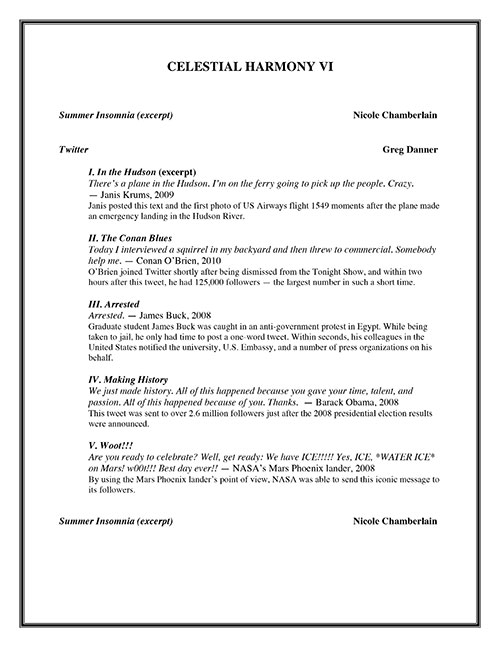
What courses are you currently teaching?
I teach applied flute, upper woodwind methods, and the four-semester music theory sequence, in addition to serving as the director of the Henderson State University Flutes ensemble and the coordinator of the music theory division. I also teach Humanities: Music online during the summer semesters and have taught Music Education Technology, Aural Skills, and Introduction to Music Literature in previous semesters.
What curriculum do you use to prepare students to become music educators?
Private flute teachers in southern Arkansas are scarce, so most of my students do not take lessons prior to college. I actually start working with some students before they attend college. When area flutists attend the band camp or all-state masterclasses we offer, I give them my Google Voice number and encourage them to send me recordings of their all-state music for feedback and then give them mini-lessons over text. (Google Voice is free and converts all voicemails to text. It is the perfect alternative to giving out a private cell number.) I will often respond with an unlisted YouTube video that caters to their particular issues. These exchanges are not replacements for regular private lessons, but they give these rural students some feedback to help them become more prepared for college.
HSU has ensemble placement auditions in August and November. A colleague and I judge these blind auditions using the Arkansas School Band and Orchestra Association’s all-state audition rubric. Each audition consists of 1-3 orchestral excerpts and sightreading. (Non-majors can choose to only audition on one excerpt if they are not vying for a position in a top ensemble. All music majors are required to audition on both flute and piccolo.) The audition is recorded and uploaded to Google Drive, along with the score sheets. Scores are posted on the private HSU Flutes Facebook group page, and students are invited to see their score sheets and hear their audition recordings.
I congratulate every student who has raised their score from a previous audition and praise the studio when the overall average score increases. We emphasize that individual progress is not as important as the progress of the studio as a whole. As a result, upperclassmen often volunteer their time to help the non-majors and underclassmen prepare for these auditions.
The audition rubric has separate categories for pitch accuracy, rhythm accuracy, tone, and musical expression, so deficiencies are easy to identify. Theoretically, a student could collect these score sheets and track their progress from seventh grade through their last year of college. The students and I review their score sheets and jury evaluations every semester and create a Student Improvement Plan (SIP). Although I have required repertoire categories for every student in my syllabus, the grading scale and technique requirements are personalized through each student’s SIP each semester.
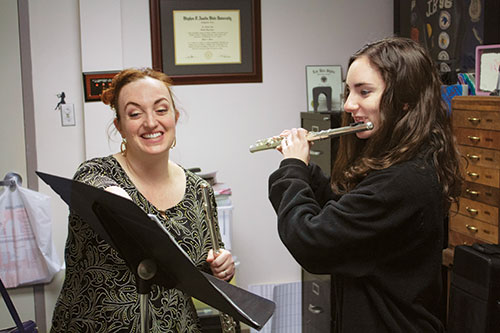
Rhythm-reading is generally the weakest area for incoming freshmen. All students must demonstrate mastery of the basic rhythm cells found in the first chapter of Patricia George and Phyllis Louke’s The Flute Scale Book. Students track their sightreading progress through SmartMusic’s graded sightreading levels. I use Daniel Kazez’s Rhythm Reading and John Kember and Catherine Ramsden’s Flute Sight-Reading series for additional fundamental rhythm-reading exercises. We use the same counting system (a hybrid of the 1-e-&-a and Eastman’s 1-la-li systems) that is used in the theory and aural skills classes, with emphasis placed on musical homophones – rhythm cells that sound the same but are notated differently.
At the suggestion of Christie Beard, I start every lesson with a duet sightreading session with the student playing the top part. They know that the duet sessions are designed to address deficiencies in their rhythm-reading skills and will pick duets accordingly. One student recently declared, “I need some compound meter in my life,” as he searched through my duet books looking for a particular rhythm cell that was challenging him in wind ensemble rehearsals.
I generally try to match technique exercises to the skills that are being learned in the core piano, theory, and aural skills classes. For example, Piano I students are required to play all major and minor pentascales, so my freshmen’s first technique assignment is to memorize the major and minor pentascales found in The Flute Scale Book. (These are similar to Taffanel and Gaubert #1 and #2.) If the aural skills or piano professor alerts me that a student is struggling with this, I will further incorporate those skills into our practice. I will have a student play a major pentascale at the piano, sing it using moveable-do solfege syllables, and then play it on the flute in all octaves. Sometimes they simultaneously sing and play these pentascales, as Robert Dick suggests in his instructional YouTube throat-tuning video. They progress through The Flute Scale Book to tone color scales (similar to Taffanel and Gaubert #4) in order to become more comfortable with the minor scale forms and third-octave wiggles to become more comfortable with real and trill fingerings in the third octave.
I use The Flute Scale Book’s harmonic exercises for tone development but also turn to other sources. I try to adopt a different flute method book every year so that students have a collection when they graduate. No one book meets everyone’s needs. The CD that accompanies Trevor Wye’s tone practice book is very helpful for students who need an aural model to develop their flute tone. Playing along with the backing tracks in Lisa Garner-Santa’s The Flute Theory Book is a fun way to practice scales, and Terri Sanchez’s warm-ups found on her website and in The Aspiring Flutist’s Practice Companion are very inspiring. Who wouldn’t want to play along with Katy Perry’s Roar to practice double-tonguing?
Do you have a weekly studio class?
Our weekly studio class is an opportunity for students to perform on the recital hall stage and to practice teaching. Students perform multiple times per semester and are asked to tell the class what specific feedback they want from each performance. Underclassmen generally ask for generic feedback about tone quality, vibrato speed, and dynamic contrast, but upperclassmen usually poll the collective flute mind on more complex topics, such as writing a cadenza. I try to host a guest artist for a masterclass once or twice per year and often take studio trips to flute festivals and masterclasses at other universities. For some of my students, these trips are the first time they travel outside the state of Arkansas. I am hoping that we can raise enough money next year to take the entire studio to the NFA convention in Dallas.
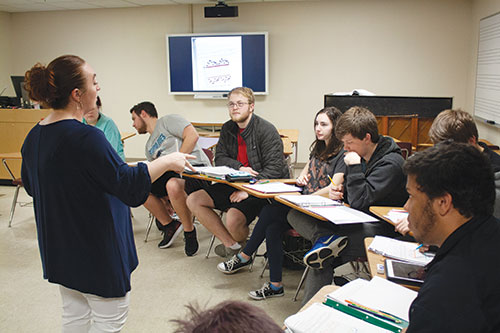
What performances does the flute choir play each year?
We perform with the clarinet choir and saxophone quartet on a shared woodwind chamber ensemble program every semester. I choose repertoire specifically to teach a certain concept or address a particular deficiency in the ensemble. When students were struggling with intonation, they played Christie Beard’s arrangement of Sleep. They combined with the clarinet choir to perform Chappell Kingsland’s A Drop of Golden Sun one year when students in both groups were struggling with balance and blend in wind ensemble and symphonic band. One semester, the twenty students enrolled in flute choir were struggling with matching articulation, so I programmed Ricky Lombardo’s arrangement of John Philip Sousa’s The Fairest of the Fair. The majority of these pieces are performed unconducted so students can learn basic chamber music skills, but I occasionally give seniors the opportunity to conduct. Student conductors are given easier selections from the state solo/ensemble list and are expected to lead rehearsals as if they were directing their own high school flute ensemble.
Once or twice a year, we go on a short tour to perform for area schools, churches, and hospitals. These performances generally feature pieces that appeal to these audiences, such as Michal Rosiak’s Angry Tunes and Lisa Ochoco’s arrangement of Queen’s Bohemian Rhapsody. I reserve time after each performance for students to mingle and field questions so that they learn how to interact with different populations – middle school and high school students, nursing home residents, and potential benefactors. The music department has a very limited budget, so we rely on donations for van rentals, hotel rooms, and low flute purchases. When the department receives a request for an ensemble to perform for a benefit dinner or church service, the flute choir is the first to volunteer. We also give concerts in area churches, who take up an offering for us.
In preparing the flute choir for a concert, what are the key concerns that you address?
I have always strived to make the flute choir open to everyone, regardless of major or ability, and it often consists of more non-majors than music majors. Non-majors drift in and out of the ensemble as their schedules allow. This results in a group of ten to fifteen members that may radically change each semester. I try to select repertoire that allows parts to be doubled in case we lose someone, but we often find ourselves in a bind when someone falls ill or does not continue after one semester. In these instances, I call upon an alumnus to sub on the missing part or play it myself.
Developing a homogenous sound is difficult. We spend many rehearsals at the beginning of each semester playing rounds in different keys. Some of our favorites include Mahler’s minor Frère Jacques and Rose, Rose found in Flute 101. I ask students to play them in all keys, often with cello drones or various students acting as drones. The music majors transpose using solfege syllables, but I teach the non-majors how to transpose using scale degree numbers. I use rounds instead of a tuning pitch for most rehearsals and performances.
Rhythmic independence is also difficult for flute choir members. I spend the first few rehearsals of a new piece doing activities away from the flute. If there is a recording available, I will play it for them as they follow along in their parts. I have them do a basic formal analysis by answering questions such as “where is the climax of this piece?” or “what musical elements contribute to the emotion in this passage?”
A few years ago, my friend Ginny Hudson introduced me to using various drum beats on YouTube rather than a metronome. Now they are a staple of our rehearsals. Students often will sizzle rhythms or chant rhythm words with a drum beat in the background sometimes while walking to the beat in a circle. As students develop confidence, they slowly begin to sing passages to emphasize dynamics, articulation, and intonation. They play in a circle, with the low flutes across from the C flutes, until a couple of rehearsals before a performance. When they perform, I place them in a traditional set-up.
Where did you grow up?
I spent my youngest years in Childress, a small town in the Texas panhandle. My mother eventually accepted a job as a nursing home administrator in Mt. Pleasant, a slightly larger town in East Texas about two and a half hours from Dallas. This is where my musical studies began. I took weekly piano and music theory lessons from Irma Barrett, a pianist and organist at the local Baptist church. She was a stern but patient woman who introduced me to the Texas Music Teachers Association music theory tests and National Piano Guild auditions. I honestly was never a very strong performer, but I excelled at the theory tests. The curriculum was fun to me; it was like solving puzzles.
My piano technique was not strong when I arrived at college, but my background served me well. I was able to test out of class piano and enrolled in lessons with Ann Rye, who remained patient with me as I struggled with polyrhythms in pieces like Debussy’s first Arabesque. Thankfully, Dr. Rye accepted me at my commitment level. I try to remember her quiet sighs and patient voice when I become frustrated with my students for not practicing enough. In my early years of teaching private flute lessons in Texas, I was able to accompany my own students for recitals and solo/ensemble contests. I am too embarrassed by my piano technique to play with students publicly now, but I often accompany them in lessons and play excerpts in theory classes.
My one major regret with piano is that I wish I had explored jazz piano. Irma Barrett was a graduate of Baylor University in the 1930s and a staunch Southern Baptist who regarded jazz and alcohol as sinful. When I asked her for help with my jazz band audition music, she told me that she did not play that type of music in her house. I had never played anything that was not explicitly on the page and had no idea how to interpret jazz chord symbols despite being quite comfortable with Roman numerals. Improvising gave me terrible anxiety, so I avoided it. During all-region jazz band auditions, I would bite the fingernails on my left hand while my right hand shook and dared to press a key. When presented with the opportunity to take a solo, I always politely declined unless I could locate a notated version. I think I may finally be ready to take the plunge and sign up for my colleague’s jazz improvisation class now that I am 40!
How did you start playing the flute?
Initially, I wanted to play the oboe, but my band director told me that my “lips weren’t made for the oboe.” I have no idea what his reasoning was, but I decided to play the flute instead. My mother found an Artley at a garage sale for $100. It took me two weeks to make a sound on the headjoint, even though my clarinet-playing friend down the street could get a sound immediately. I started as one of two flutes in a sixth grade beginning band class under the direction of Carol Wallace, a saxophonist. During my seventh-grade year, our community chamber music series hosted the Virtuosi Wind Quintet, and my mother purchased tickets. I had never heard a professional flutist or much classical music besides the piano repertoire I played and heard in area recitals. It was an incredible experience. When I discovered that the flutist would be teaching at the West Texas State University band camp, I begged to go. I signed up for lessons with the assistant high school band director, Dick Eckstein, a trombonist, to prepare the audition music. He tried to teach me the mysteries of that magical vibrato warble I had heard in the professional flutist’s tone. Off I went to band camp, where I was placed in the middle of the section of the fifth band. I was distraught; I was first chair back home. However, as I listened to the first flutist of the top band play a solo with that ensemble, I was amazed. She was only a couple of years older than me and was studying at the Juilliard Pre-College. I had no idea how to get to that level, but I was inspired to try.
During my ninth-grade year, I started studying with a flute teacher who had moved to the area. Susan Farr had studied both flute and piano at East Texas State University, and she instantly became my idol. I was not very serious about flute at the time and never practiced efficiently; I preferred sightreading to practicing. My favorite lessons were sightreading sessions where I would read through a stack from a shelf, and she would accompany me at the piano. These lessons were so much more fun than the ones in which I slaughtered scales. She was such a patient woman and took me to my first flute festival, the Texas Flute Festival in Denton.
What led you to a career in music?
Honestly, I was not sure that music was the right choice throughout most of my life, and my career path has been haphazard and circuitous. During the fall of my senior year of high school, I was fairly certain I wanted to major in mathematics. I had no idea what one did with a math degree, but I liked spending hours working problems with concrete answers. Halfway through my senior year, someone asked if I was interested in majoring in music education. I could picture myself teaching band and math, so I began auditioning at schools throughout Texas that would allow me to double major in math and music.
The trumpet and low brass professors at Henderson State University visited my high school band class one day on a recruiting tour. I was practicing a Bach sonata in the band room after school when they approached me and asked if I wanted to come tour their liberal arts school in Arkadelphia. I had never heard of the town and secretly chuckled at the name, but I asked my mom that evening if we could go to Arkansas to look at colleges.
My visits to the Texas schools were scheduled during mass audition days. I played for the flute professor and had little time to ask questions. Scholarship money was scarce. When I visited Henderson, the band director spent quite a bit of time answering questions from my mom and me. After the audition, I was handed both a music and an academic scholarship offer. The amount covered all of my tuition, room, board, and fees for four years. My mom told me that the offer was too good to pass up. Without the pressure of high tuition bills and student loan payments, my parents were able to buy me a new flute and send me to camps, masterclasses, and workshops.
I married during my senior year of college and followed my husband to East Texas where he was slated to begin working in healthcare administration alongside my parents. I was not quite sure what I wanted to do and initially thought I would join my family in a healthcare career. I quickly realized that I would rather teach music. Stephen F. Austin State University was only an hour drive from our house, and the assistantship they offered allowed me to obtain a M.M. in flute performance without taking out student loans. Diane Boyd-Schultz was so incredibly patient with me even though I had a lot of deficiencies in my technique. Her pedagogy class prepared me for a college-teaching career long before I ever knew I would have one.
My husband’s job moved us to Houston shortly thereafter, and I began studying with Sydney Carlson while teaching private lessons in the Deer Park and Pasadena school districts. She showed me how theoretical analysis can be used to shape musical expression, and I credit her with developing my passion for music theory. After my daughter was born, I needed health insurance and took a position teaching beginning band. After only one year, my husband’s job moved us again – this time to Bryant, Arkansas.
What brought you to HSU?
When I began teaching adjunct flute at Henderson, I was teaching high school band at North Little Rock High School during the day. There were only four flutists in the entire HSU band program and only one flute (music education) major. I taught applied lessons to three students and coached a flute quartet one evening a week. Within a couple of years, the studio had grown to seven majors and two minors, and the flute quartet had expanded into a sextet.
There are no doctoral programs in music offered in the state of Arkansas, so I enrolled in the DMA program at the University of Memphis where I studied with Bruce Erskine and Elise Blatchford. They were incredibly accommodating, allowing me to attend classes three days per week so that I could continue to teach at HSU while still holding a teaching assistantship. I drove six hours round-trip three days per week so that I could be at home with my daughter as much as possible. When HSU promoted my adjunct position to a full-time, non-tenure track instructor line, I relinquished my teaching assistantship and applied for in-state tuition through the Academic Common Market program. I volunteered every time the music department at HSU needed someone to teach a class. Professor Blatchford was gracious with her time, often dedicating two to three hours on weekends or teaching me via Skype so that I could continue to take lessons while I was teaching an overload of 18 hours. By the time I graduated from the University of Memphis, HSU had converted my position into a tenure-track position.
What advice would you offer about selecting a college program?
If you want to major in music, weigh the cost of your education against your potential salary. The job market is flooded with so many unemployed music graduates who have six figures in student loan debt that cannot easily be paid back at the 5-7.5% interest rate. When you audition for schools, ask for their job and graduate school placement rates. Visit campuses outside of the normal audition days and ask to observe classes, rehearsals, and lessons. Ask what opportunities are available to you as an undergraduate music major, music minor, and non music major. Look for programs that will support personal development as much as musical skills. Interactions with faculty and students during the audition and application process will likely mirror the experiences you will have as a student. Relationships with peers and professors are just as valuable to your career as the curriculum, so choose accordingly.
As the mother of a young musician, what advice do you have for parents?
Music is a language learned through immersion. Students need ample opportunities to hear live music. My daughter, Madeleine, has grown up listening to music. I used to conduct flute choir while holding her on my hip. When Mad was three years old, she accompanied me to a gig with an oboist friend and declared that she was “going to play the hobo like Miss Shannon.” By the time she enrolled in oboe lessons with “Miss Shannon” in sixth grade, she had listened to countless recitals of both flute and oboe music. Like most kids, she did not always choose to practice regularly or correctly, but she knew what an oboe should sound like and what a practice session should look like, which put her light years ahead of me at that age.
There are fewer opportunities for music students in rural towns, so it is often necessary to travel outside of the area. I am so grateful to my parents for taking me to flute festivals, camps, and masterclasses. Every year, I try to provide Mad with a new experience that exposes her to other young musicians. We attended the Arkansas Double Reed Day after she had only been playing for eight months. She attended band camp at HSU after sixth and seventh grade and Blue Lake Fine Arts Camp after eighth grade. Although she does not plan a career in music, she intends to play in community and chamber ensembles throughout her life.
What do you tell students before they begin teaching in the schools?
Create a network of experts that you can call upon when you are having difficulties. Attend conferences and contests and notice who is the expert in each niche. In our state, Stephanie Williams is the classroom technology guru; Gary Meggs is the jazz king; and Krista Spainhour and Stewart Wright are both walking annotated bibliographies of fun, educational concert band selections. Don’t be afraid to approach people. The brightest minds share their expertise freely and are usually flattered when you ask for advice.
